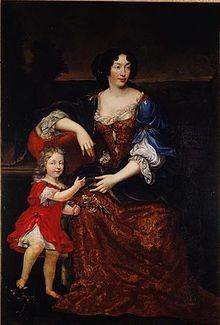Religion Roman Catholicism | ||
 | ||
Born 26 December 1646Palais du Luxembourg, Paris, France ( 1646-12-26 ) Burial Carmel of the Faubourg Saint-Jacques, Paris Issue Francis Joseph, Duke of Guise Children François Joseph, Duke of Guise Parents Gaston, Duke of Orléans, Marguerite of Lorraine Siblings Marguerite Louise d'Orléans, Françoise Madeleine d'Orléans, Jean Gaston, Duke of Valois, Marie Anne d'Orléans Similar Louis XIV of France, Françoise Madeleine d'Orléans, Marguerite Louise d'Orléans, Gaston - Duke of Orléans, Jean Gaston - Duke of V | ||
Élisabeth Marguerite d'Orléans. (26 December 1646 - 17 March 1696), known as Isabelle d'Orléans, was the Duchess of Alençon and, during her husband's lifetime, Duchess of Angoulême. She was a daughter of Gaston d'Orléans and a first cousin of Louis XIV of France. She has no descendants today. She was suo jure Duchess of Alençon and Angoulême.
Contents
Immediate family
Élisabeth d'Orléans was born in Paris at the Luxembourg Palace, then called the Palais d'Orléans, and now the seat of the Senate of France. The palace had been given to her father on the death of his mother, Marie de' Medici in 1642. Élisabeth was known by her first name, Élisabeth, but she always signed Isabelle. One of five children, she was not raised with her siblings but in a convent, because she was destined to become abbess of Remiremont and was styled as such.
Biography
Known as Mademoiselle d'Alençon until her marriage, Isabelle (Élisabeth Marguerite) was acquainted with the young Louise Françoise de La Baume Le Blanc, who was to become duchesse de La Vallière, mistress of Louis XIV, and who grew up at Blois in the entourage of Isabelle's sister Marguerite Louise d'Orléans. It was assumed that Isabelle's older and more beautiful sister, Marguerite Louise, would marry Louis, and that Françoise Madeleine would marry another European prince. A possible match was one with Charles Emmanuel II, Duke of Savoy, who later married her younger sister on 4 March 1663.
Another possible husband was her cousin Henri Jules de Bourbon - the future Prince de Condé and Prince du Sang. This was dropped as Henri Jules preferred the German Anne Henriette of Bavaria who was a granddaughter of the Queen of Bohemia.
The choice for Isabelle (who was humpbacked) fell upon a "foreign prince (prince étranger) naturalized in France": Louis Joseph de Guise. The Duke of Guise was the titular head of the House of Guise, a cadet branch of the House of Lorraine of which Isabelle's mother was a member.
Isabelle and the Duke were married at the Château de Saint-Germain-en-Laye on 15 May 1667 in the presence of the Court and the Princes of the Blood. Her husband, four years younger than she was, was not only under the legal control of his aunt and guardian, the "magnificent" and proud Mademoiselle de Guise (Marie de Lorraine de Guise), but in day-to-day protocol, he was treated by Isabelle as the social inferior that he was. From her marriage to her death, Isabelle d'Orléans was known to the French as Madame de Guise. Her brief union with the Duke of Guise produced one child:
Isabelle's husband died in 1671, from smallpox contacted on his way back from a visit to the court of Charles II, King of England. Her son inherited his father's titles: duc de Guise et de Joyeuse and prince de Joinville.
At the death of her mother in 1672, she moved into the Luxembourg Palace along with the little Francis Joseph. Still unable to walk unaided at age four, he was dropped by his nurse and died from a head injury in 1675. He died at the Luxembourg Palace.
After the death of her son, Isabelle (whom the French knew as "Madame de Guise") spent every summer in her duchy of Alençon and most winters at the royal court. When in Paris, she would stay at the Luxembourg Palace which had been ceded to her after her mother's death in 1672. (Haunted by her little son's death throes there, she found it difficult to stay very long at the Luxembourg.) In 1672 she created a private apartment for herself at the abbey of Saint Pierre de Montmartre, where she often saw Mlle de Guise and her sister, the abbess. After 1675, this little circle expanded when Isabelle's sister Marguerite Louise, Grand Duchess of Tuscany, left her husband, moved into an apartment within the abbey walls, and was kept under what amounted to house arrest. Always very devout, Isabelle commissioned religious pieces from Marc-Antoine Charpentier, the composer of Mlle de Guise. She also commissioned secular works (operas and pastorales) from him, some of which were performed at the royal court.
Isabelle was a fervent supporter of her cousin Louis XIV's policies to bring Huguenots back into the Catholic fold. As early as November 1676, when she supervised the conversion of a Protestant lady, Isabelle commissioned from Marc-Antoine Charpentier the first of a succession of oratorios that recounted how St. Cecilia had won over her bridegroom and his brother to Christianity. The probable author of the libretti was Philippe Goibaut, a protegé of the two Guise women. After the Revocation of the Edict of Nantes in October 1685, she created a house for "New Converts" in her duchy of Alençon and actively converted the local Huguenots.
In 1694, she gave the Luxembourg Palace to Louis XIV. She died in 1696 at the Palace of Versailles and was buried in the Great Carmel of Paris, among the nuns.
The fortune that she had accumulated was willed to her older and only surviving sibling, Marguerite Louise, Grand Duchess of Tuscany.
Titles and styles
Upon her son's death, she became the Duchess of Alençon and Angoulême in her own right. She kept her rank of Granddaughter of France during her marriage. This allowed her the style of HRH (Son Altesse Royale).
